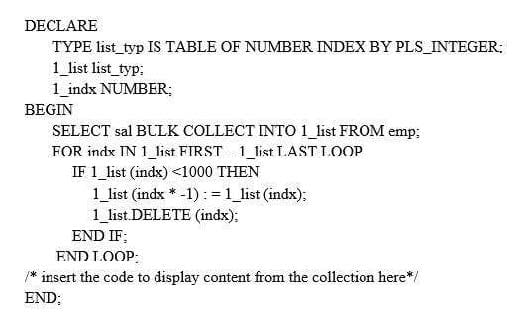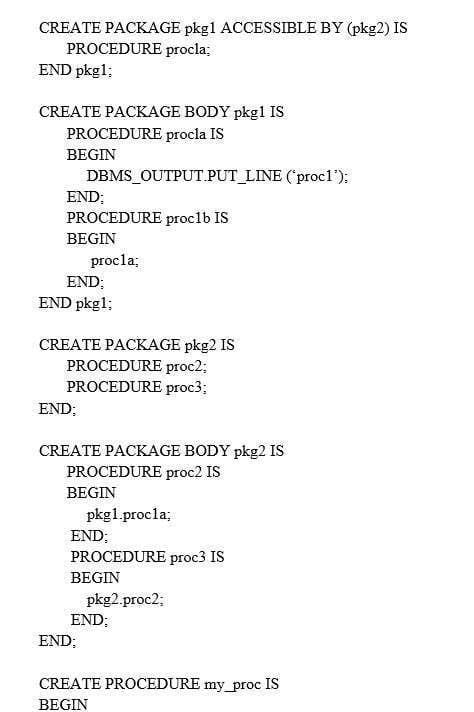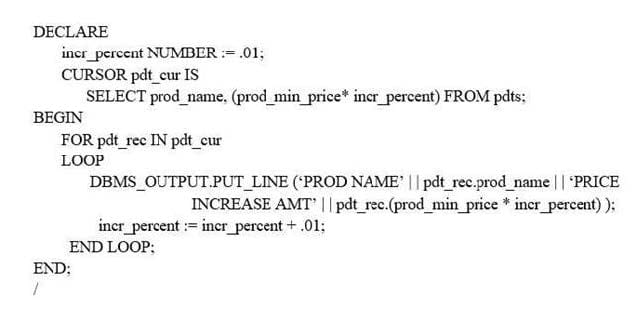Exam Details
Exam Code
:1Z0-148Exam Name
:Oracle Database: Advanced PL/SQLCertification
:Oracle CertificationsVendor
:OracleTotal Questions
:243 Q&AsLast Updated
:Jun 28, 2025
Oracle Oracle Certifications 1Z0-148 Questions & Answers
-
Question 61:
Examine the structure of the EMP table:
Name Null? Type —————— ————– ——————— EMPNO ENAME NOT NULL NUMBER (4)VARCHAR2 (10) SAL NUMBER (7, 2) Examine this code: 
Which code should be inserted to display the collection contents?
A. 1_indx := 1_list.FIRST; WHILE (1_indx IS NOT NULL) LOOP DBMS_OUTPUT.PUT_LINE (1_indx || ‘ ’ || 1_list (1_indx)); 1_indx := 1_emp.NEXT (1_indx); END LOOP;
B. FOR indx IN 1_list. COUNT .. -1 LOOP DBMS_OUTPUT.PUT_LINE (indx | | ‘ ’ | | 1_list (indx)); END LOOP;
C. FOR indx IN -1 .. 1_list.LIMIT LOOP DBMS_OUTPUT.PUT_LINE (indx | | ‘ ’ | | 1_list (indx) ); END LOOP;
D. FOR indx IN 1_list.FIRST . . 1_list.LAST LOOP DBMS_OUTPUT.PUT_LINE (indx | | ‘ ’ | | 1_list (indx)); END LOOP;
-
Question 62:
Which two statements are true regarding edition-based redefinition (EBR)?
A. There is no default edition defined in the database.
B. EBR does not let you upgrade the database components of an application while in use.
C. You never use EBR to copy the database objects and redefine the copied objects in isolation.
D. Editions are non-schema objects.
E. When you change an editioned object, all of its dependents remain valid.
F. Tables are not editionable objects.
-
Question 63:
Examine the incomplete code:

Which three lines of code must be added for it to successfully compile?
A. curid := DBMS_SQL.TO_CURSOR_NUMBER (src_cur);
B. src_cur := DBMS_SQL.TO_REFCURSOR (curid);
C. src_cur= NUMBER;
D. curid NUMBER;
E. curid SYS_FEFCURSOR;
F. src_cur SYS_REFCURSOR;
-
Question 64:
Examine this code:

The anonymous block fails with:
ERROR at line 1:
ORA-01403: no data found
ORA-06512: at line 5
Which two are valid options to prevent this error from occurring?
A. Line 5 should be replaced with: DBMS_LOB.CREATETEMPORARY (pdatabuf (1), TRUE, DBMS_LOB.CALL);
B. Line 5 should be replaced with: DBMS_LOB.CREATETEMPORARY (pdatabuf (1), FALSE, DBMS_LOB.SESSION);
C. Rewrite the block as: DECLARE TYPE databuf_arr IS TABLE OF CLOB INDEX BY BINATY_INTEGER; pdatabuf databuf_arr; PROCEDURE mytemplob (x OUT CLOB) IS BEGIN DBMS_LOB.CREATETEMPORARY (x, TRUE, DBMS_LOB.SESSION); END; BEGIN mytemplob (pdatabuf (1)); END; /
D. pdatabuf (1) := NULL; should be added after line 4.
E. Line 5 should be replaced with: DBMS_LOB.CREATETEMPORARY (pdatabuf, TRUE, DBMS_LOB.SESSION);
-
Question 65:
Examine these program units: Which two blocks will execute successfully?

A. BEGIN My_proc; END;
B. BEGIN pkg2.proc3; END;
C. BEGIN pkg2.proc2; END;
D. BEGIN pkg1.proc1a; END;
E. BEGIN pkg1.proc1b; END;
-
Question 66:
Examine this block of code used to calculate the price increase for all the productivity by 1% and then by 2%.

What will be the outcome on execution?
A. It will give an error because the calculated column in the cursor is not using a column alias in this block.
B. It will go into an endless loop because the loop exist condition is missing.
C. It will display the price increase by 1% only for all the products.
D. It will display the price increase by 1% only for the first product.
E. It will give an error because PDT_REC is not declared.
-
Question 67:
Examine this function body:
BEGIN SELECT hire_date INTO date_hired FROM employees WHERE employee_id=emp_id;RETURN TO_CHAR(date_hired);
END;
Which two headers will allow this function to compile successfully and take advantage of both invoker's rights and function result caching?
A. CREATE FUNCTION get_hire_date (emp_id NUMBER) RETURN VARCHAR2 RESULT_CACHE RELIES_ON (departments) AUTHID CURRENT_USER IS date_hired DATE;
B. CREATE FUNCTION get_hire_date (emp_id NUMBER) RETURN VARCHAR2 RESULT_CACHE AUTHID CURRENT_USER IS date_hired DATE;
C. CREATE FUNCTION get_hire_date (emp_id NUMBER) RETURN VARCHAR2 RESULT_CACHE AUTHID DEFINER IS date_hired DATE;
D. CREATE FUNCTION get_hire_date (emp_id NUMBER) RETURN VARCHAR2 RESULT_CACHE RELIES_ON (employees) AUTHID CURRENT_USER IS date_hired DATE;
E. CREATE FUNCTION get_hire_date (emp_id NUMBER) RETURN VARCHAR2 AUTHID DEFINER IS date_hired DATE;
-
Question 68:
Refer to the Exhibit.

Examine this procedure created in a session where PLSQL_OPTIMIZE_LEVEL =2:

PL/SQL tracing in enabled in a user session using this command:
EXEC DBMS_TRACE.SET_PLSQL_TRACE (DBMS_TRACE.TRACE_ENABLED_LINES)
The procedure is executed using this command:
EXEC PRC_1
Examine the exhibit for the content of the PLSQL_TRACE_EVENTS table.
Why is tracing excluded from the PLSQL_TRACE_EVENTS table?
A. DBMS_TRACE.TRACE_ENABLED_LINES traces only exceptions in subprograms.
B. PRC_1 is not compiled with debugging information.
C. Tracing is not enabled with the TRACE_ENABLED_CALLS option.
D. PRC_1 is compiled with the default AUTHID DEFINER clause.
E. Tracing will be enabled only for the second execution of PRC_1.
-
Question 69:
Which statement is true about internal and external LOBs?
A. An external LOB can be loaded into an internal LOB variable using the DBMS_LOB package.
B. A NOEXIST_DIRECTORY exception can be raised when using internal and external LOBs.
C. Internal and external LOBs can be written using DBMS_LOB.
D. After an exception transfers program control outside a PL/SQL block, all references to open external LOBs are lost.
E. When using DBMS_LOB.INSTR for internal and external LOBs, DBMS_LOB.OPEN should be called for each LOB.
-
Question 70:
Which two blocks of code execute successfully?
A. DECLARE TYPE tab_type IS TABLE OF NUMBER; my_tab tab_type; BEGIN my_tab (1) :=1; END;
B. DECLARE TYPE tab_type IS TABLE OF NUMBER; my_tab tab_type := tab_type(2); BEGIN my_tab(1) :=55; END;
C. DECLARE TYPE tab_type IS TABLE OF NUMBER; my_tab tab_type; BEGIN my_tab. EXTEND (2); my_tab (1) := 55; END;
D. DECLARE TYPE tab_type IS TABLE OF NUMBER; my_tab tab_type; BEGIN my_tab := tab_type (); my_tab (1) := 55; END;
E. DECLARE TYPE tab_type IS TABLE OF NUMBER my_tab tab_type := tab_type (2, NULL, 50); BEGIN my_tab.EXTEND (3, 2); END;
Related Exams:
1Z0-020
Oracle8i: New Features for Administrators1Z0-023
Architecture and Administration1Z0-024
Performance Tuning1Z0-025
Backup and Recovery1Z0-026
Network Administration1Z0-034
Upgrade Oracle9i/10g OCA to Oracle Database OCP1Z0-036
Managing Oracle9i on Linux1Z0-041
Oracle Database 10g: DBA Assessment1Z0-052
Oracle Database 11g: Administration Workshop I1Z0-053
Oracle Database 11g: Administration II
Tips on How to Prepare for the Exams
Nowadays, the certification exams become more and more important and required by more and more enterprises when applying for a job. But how to prepare for the exam effectively? How to prepare for the exam in a short time with less efforts? How to get a ideal result and how to find the most reliable resources? Here on Vcedump.com, you will find all the answers. Vcedump.com provide not only Oracle exam questions, answers and explanations but also complete assistance on your exam preparation and certification application. If you are confused on your 1Z0-148 exam preparations and Oracle certification application, do not hesitate to visit our Vcedump.com to find your solutions here.